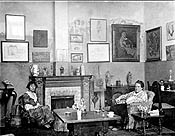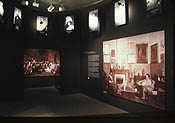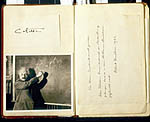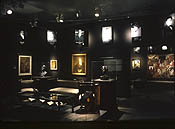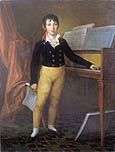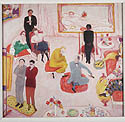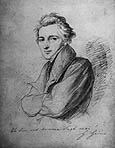The browser will either open the file, download it, or display a dialog.
|
The Power of Conversation: Jewish Women and Their Salons McMullen Museum of Art, Boston College Emily D. Bilski and Emily Braun, Jewish Women and Their Salons: The Power of Conversation. With contributions by Leon Botstein, Shira Brisman, Barbara Hahn, and Lucia Re. New York: The Jewish Museum; New Haven: Yale University Press, 2005. |
|||
| Until quite recently, cultural historians working on the long nineteenth century paid little attention to the institution of sociability known as the salon. Despite significant amounts of evidence, including memoirs, letters, newspaper accounts, and pictures, testifying to the continued existence of salons in the modern period, scholarship on nineteenth-century artistic, musical, literary, and political culture has tended to marginalize them. There are various reasons for this: the ephemeral social interactions of salon practices can elude text- and object-based-methodologies, while the salon's associations with femininity, domesticity, and amateurism have left it struggling to seem significant among dominant narratives that focus on the masculine, the public, and the professional.1 The pervasiveness of nostalgia in nineteenth-century accounts of salons has not helped either. Scholars have at times interpreted such nostalgia for the salons of the Enlightenment or the précieuses as a marker of the moribundity of the institution, rather than as a tropic form of institutional memory.2 In fact, as Steven Kale has recently, and forcefully, argued in the French context, salons were alive and well in the nineteenth century.3 The very word salon was, according to the Grand Robert, first used in France to describe a gathering of 'society' in 1807, and salons were probably more numerous, more institutionally coherent, and more influential in the nineteenth century than in earlier periods.4 | |||
| Although many variations existed, nineteenth-century salons shared some general characteristics. They were regular gatherings in private homes of mostly elite men and women, who came primarily to talk, but also to see and hear short theatrical and musical performances, to listen to readings from literary texts or memoirs, to play games, and/or to watch artists improvise. Often salons were presided over by a salonnière or hostess (though male-led salons were also an important category), whose role was to facilitate conversation, and generally, to bind together the assembled group. Though several historians have argued that the role of salonnière, with its requirements for politeness and agreeableness, reinscribed gender norms linked with patriarchy, and thus should not be considered proto-feminist, some women were able to use their salons to exert significant influence on artistic and political affairs when doing so by other means was very difficult.5 Indeed, it was precisely the salon's associations with a feminized private sphere that allowed it to function effectively as a sheltered space of conciliation during periods of political factionalism, and as a means of integration for social groups excluded from more public arenas. | |||
| The idea that the salon could be a progressive institution is the driving force behind a fine new exhibition at the Jewish Museum, "The Power of Conversation: Jewish Women and Their Salons." Taking as its point of departure the fact that "Jewish women form a disproportionately large number of the most influential and discussed salonières [sic]" in the modern period, the exhibition explores the salon as "a vehicle of female emancipation and assimilation for Jews" in Europe and America from the late-eighteenth century until the Second World War.6 This thesis is laid out in detail by the show's co-curators, Emily Bilski and Emily Braun, in a substantial essay in the book accompanying the show.7 Their narrative begins in Germany in the late eighteenth century, a period when the dissemination of French Enlightenment ideas concerning equality and secularity appeared to offer wealthy Jews unprecedented opportunities for integration with non-Jewish elites. The salon was a space where such mixing could occur. Well-prepared for the role of salonnière by Jewish cultural traditions that emphasized education, debate, mediation, and cosmopolitanism, several Jewish women emerged in Berlin to lead dynamic and successful salons that attracted prominent Jews and non-Jews alike.8 As Bilski and Braun point out, the utopian potential of the salon had its limits; some of the Jewish salonnières' non-Jewish guests continued to express anti-Semitic views in private, and rarely reciprocated the invitations of their hostesses.9 Nevertheless, the authors argue, the Berlin salons, "inspired an ideal of sociability and integration, and a model for the role that Jewish women could play in shaping intellectual and cultural life in the modern world."10 The remainder of their essay explores how subsequent Jewish salonnières drew upon and extended this model as they used their salons to stimulate intellectual exchange, foster and influence avant-garde cultural movements, pursue artistic goals, and organize resistance to anti-Semitism. | |||
| At the Jewish Museum, the exhibition starts towards the end of the historical trajectory mapped by Bilski and Braun's essay with a room devoted to Gertrude Stein and her 'at-homes' in early-twentieth-century Paris (fig. 1). Presumably driven in part by a desire to showcase some of the best-known figures in the exhibition, the decision to begin with Stein also underlines one of the show's key claims, which is that the salon tradition in general, and the Jewish salon tradition in particular, played a significant role in shaping aspects of modernism. In an accompanying discussion of the relationship between the salon and literary modernism, Lucia Re argues that "the experience of the salon, with its complex, fluid, and, to some, 'wasteful' conversations" subverted Victorian bourgeois norms, troubled "categories of narrative time and space, historical continuity and linearity," and laid the groundwork for the literary experimentation of Proust, Wilde, and Stein.11 After Stein, the exhibition moves into a broadly chronological sequence, interspersed with thematic elements. Thus, following a brief display devoted to the origins of the salon in pre-Revolutionary France, the viewer encounters rooms that explore Henriette Herz and Rahel Levin Varnhagen's Berlin salons; the attempt by the sisters Fanny von Arnstein and Cäcilie von Eskeles to export Berlin sociability to Vienna; Amalie Beer and Fanny Hensel's music salons; Ada Leverson and Geneviève Straus's late-nineteenth-century literary salons; Berta Zuckerkandl's Secessionist salon; the political salons of Anna Kuliscioff and Margherita Sarfatti in early-twentieth-century Italy; the remarkable Florine Stettheimer's salon in early-twentieth-century New York; and Salka Viertel's California salon that "offered a sense of home" for refugees from Hitler's Germany.12 | |||
| As the director of the Jewish Museum acknowledges in a foreword to the exhibition book, devoting a show to an institution organized primarily around conversation poses significant design problems.13 As part of the exhibition's solution to these problems, reproduced portraits of salon participants are suspended above viewers' heads in each room (fig. 2). Attached to many of the portraits are numbers that visitors can punch into an audio guide in order to hear a text by or about the person depicted. As a means of emphasizing the role of the voice in salon culture, and of stimulating some interaction between visitors and the exhibition, this works rather well. Rarely, in fact, has the audio guide been so essential to a museum-going experience; as well as supplying the viewer with these readings and the usual kind of introductory material, it delivers excerpts of music likely to have been heard at salon gatherings and, at times, sound collages suggestive of the slightly cacophonous nature of a talk-centered social world. Filling out the structure provided by the overhead displays and the audio guide is a broad selection of artifacts associated with salon life, including portraits of salonnières in various media, invitations, musical scores and instruments, letters, books, and furniture14 (fig. 3). Unfortunately, many of these objects are presented somewhat conventionally in glass cases or on slightly elevated, roped-off platforms, with the effect of removing them from the intimate context of the salon and firmly situating them within the display rhetoric of the public museum (fig. 4). Though the dark-toned walls and subdued lighting compensate by creating a soft viewing atmosphere, one wonders if more could have been done to simulate the haptic relationship between viewers and objects, especially furniture, that was at times characteristic of salon experience. | |||
| For art historians, one of the most intriguing aspects of the exhibition is the question it raises concerning the relationship between portraiture and the salon. That this is an important relationship is signaled by the exhibition design itself, which, as we have seen, uses suspended portraits of salon participants to evoke their presence for the viewer. Often featuring photographs or images presented as if they are photographs, these overhead displays make use of a particular understanding of the photographic portrait as a special kind of representation that, by virtue of an indexical relationship between the sitter's body and the two-dimensional image perceived by the viewer, preserves a seemingly authentic trace of the past and subjectivity itself. As modern theories of the photographic image often note, such a reading of the medium's epistemology generates a concomitant perception of loss as the photograph's insistence on a subject's presence forces an encounter with his or her absence.15 By using photographs to display the simultaneous presence and absence of the salonnières, the organizers of "The Power of Conversation" reproduce, perhaps unconsciously, the atmosphere of nostalgia that is so pervasive in nineteenth-century accounts of salon life.16 | |||
| Ironically, despite the desire for unmediated access to famous salon participants encoded in the design scheme, many of the portraits exhibited as salon artifacts are anything but transparent. As Bilski and Braun observe, few images of women actually performing the role of salonnière exist, even though playing such a role was a crucial element in the identities of those who did it.17 Avoiding explicit identification as a shaper of public discourse was probably a sensible strategy for many salonnières living in contexts hostile to the participation of women in public life, with the dangers for Jewish women being particularly acute. The risks run in general by early-nineteenth-century European Jews who wished to fix and circulate images of themselves as culturally sophisticated are well illustrated by the reception of one particular painting in the exhibition, Friedrich Georg Weitsch's Childhood Portrait of Jacob Meyer Beer (1802) (fig. 5). Commissioned by Meyerbeer's family to celebrate his precocious musical abilities, the portrait became the focus of anti-Semitic commentary when it was exhibited publicly at the Academy of Arts in Berlin necessitating its removal to the Beers' private residence.18 | |||
| In this context, it is not surprising that many of the salon women featured in the exhibition sought portraits that alluded only indirectly to their salon activities or disavowed them altogether. Bilski and Braun note, for example, that Friedrich von Amerling's Portrait of Cäcilie Freiin von Eskeles (1832) positions the sitter at the boundary between public and private realms by representing her in clothes appropriate for promenading in the city while featuring objects, such as the books and the portrait of two children, that suggest a domestic life of quiet contemplation and familial devotion.19 Conspicuously absent is a reference to Eskeles' position as a prominent Viennese salonnière. Likewise, an important decorative element in the room Geneviève Straus used for her salon gatherings in late-nineteenth-century France was Jules-Elie Delaunay's portrait of her in mourning for her first husband, Georges Bizet, which represents the antithesis of Straus's salon role as a facilitator of lively conversation.20 An exception to this general tendency is Florine Stettheimer, whose Soirée (1917-19) depicts a scene of salon sociability taking place in a room in her Manhattan apartment decorated with a nude Self-Portrait (1915-16) (fig. 6). Archly conflating the old trope of a salonnière receiving guests on a lit de repos with references to Manet's Olympia (1863), while at the same time alluding to the commedia dell'arte, the picture creates a compelling image of Stettheimer's salon as a place of witty and knowing performances of selfhood.21 | |||
| Several other images in the exhibition also testify to a privileged relationship between salons and playful, visual practices of self-cultivation. Displayed in the room devoted to Fanny Hensel's music salon, for example, is a small selection of portrait sketches made by Hensel's husband, Wilhelm, of performers and guests at her 'Sundays.' In addition to the signature of the artist, many of these sketches carry inscriptions from the sitters that draw attention in teasing ways to the drawings' implicit claims to truthfulness. Heinrich Heine, for example, wrote on his portrait, "Eh bien, cet homme c'est moi!"22 (fig. 7) Such comments have the effect not so much of calling the image's rhetoric into question as situating it and, by extension, the truth about identity, within a world of sociable exchange. Nineteenth-century salons were quite often environments in which artists improvised portraits on the fly, with the atmosphere being particularly conducive to caricature. Auguste Jal records, for example, that at Pierre Ciceri's salon in Paris in the 1820s, artists such as Horace Vernet and Jean-Baptiste Isabey contributed to an album of caricatures of habitués that itself became a stimulus for salon banter.23 In the exhibition at the Jewish Museum the caricature tradition is represented by Max Beerbohm's drawings, which are presented by Bilski and Braun as a "visual counterpart to the verbal wit and repartee" in evidence at Ada Leverson's salon, at which Beerbohm was a regular guest (fig. 8). | |||
| By tracing the important role Jewish women played in the vibrant salon culture of the long nineteenth century, and by highlighting how these women used their salons for progressive ends, "The Power of Conversation" contributes significantly to the developing debate concerning the relationship between salon sociability and issues of ethnic, gender, and class identity in the modern period. For art historians, the exhibition is particularly exciting because it offers points of departure for thinking about how this relationship is mediated by objects such as portraits. In conjunction with a text like Ann Bermingham's groundbreaking Learning to Draw: Studies in the Cultural History of a Polite and Useful Art (New Haven: Yale University Press, 2000), "The Power of Conversation" also suggests new ways of taking seriously the often ignored varieties of amateur, improvised, and ephemeral visual culture, such as sketching and the construction of tableaux vivants (a frequent focus of salon activity). | |||
| Daniel Harkett Postdoctoral Fellow in the Society of Fellows in the Humanities Columbia University dh2169@columbia.edu |
|||
|
I would like to thank Tanya Sheehan for her helpful comments on a draft of this review. 1. An additional factor in the insistent characterization of the salon as an early modern institution within French historical studies, according to Steven Kale, is the disciplinary split between pre- and post-Revolutionary periods. See Steven Kale, "Women, the Public Sphere, and the Persistence of Salons," French Historical Studies 25, no. 1 (2002): 115. For an argument that twentieth-century historians of the French Enlightenment reproduced Rousseau's negative attitude towards salonnières, see Dena Goodman, The Republic of Letters: A Cultural History of the French Enlightenment (Ithaca, NY: Cornell University Press, 1994), 53-73. 2. Goodman, for example, treats Stéphanie de Genlis's definition of a maîtresse de maison in her Dictionnaire critique et raisonné des étiquettes de la cour (1818) exclusively as a meditation on the salonnières of the past rather than as both such a meditation and a set of instructions for the present. The book was published, Goodman says, "after the great salons had passed into memory." Goodman, The Republic of Letters, 104. 3. Kale, "Women, the Public Sphere, and the Persistence of Salons"; Kale, French Salons: High Society and Political Sociability from the Old Regime to the Revolution of 1848 (Baltimore: The Johns Hopkins University Press, 2004). See also Anne-Martin Fugier, La vie élégante ou La formation du Tout-Paris, 1815-1848 (Paris: Fayard, 1990). 4. The Grand Robert (2nd ed., s. v. "salon") credits the first recorded use of salon in this way to Madame de Staël in her novel Corinne (1807). 5. For the argument that salonnières did not subvert gender norms, see Kale, French Salons, 13-14; and Jolanta T. Pekacz, Conservative Tradition in Pre-Revolutionary France: Parisian Salon Women (New York: Peter Lang, 1999), 12. 6. Emily D. Bilski and Emily Braun, "The Power of Conversation: Jewish Women and Their Salons," in Jewish Women and Their Salons: The Power of Conversation, Emily D. Bilski and Emily Braun, with contributions by Leon Botstein, Shira Brisman, Barbara Hahn, and Lucia Re (New York: The Jewish Museum; New Haven: Yale University Press, 2005), 3. 7. Bilski and Braun, "The Power of Conversation." 8. Ibid., 16-17. 9. Ibid., 19, 33. Barbara Hahn's contribution to the book accompanying the exhibition also seeks to temper some of the utopian claims previously made for the Berlin salons. Barbara Hahn, "A Dream of Living Together: Jewish Women in Berlin Around 1800," in Bilski and Braun, Jewish Women and Their Salons, 149-157. 10. Bilski and Braun, "The Power of Conversation," 33. 11. Lucia Re, "The Salon and Literary Modernism: Proust, Wilde, Stein," in Bilski and Braun, Jewish Women and Their Salons, 171. In addition to the essays by Hahn and Re, the exhibition book contains a very useful discussion by Leon Botstein of the relationship between nineteenth-century music salons and constructions of gender and Jewish identity. Leon Botstein, "Music, Femininity, and Jewish Identity: The Tradition and Legacy of the Salon," in Bilski and Braun, Jewish Women and Their Salons, 159-169. 12. Bilski and Braun, "The Power of Conversation," 145. 13. Joan Rosenbaum, foreword to Jewish Women and Their Salons, by Bilski and Braun, ix. 14. While the accompanying book contains many fine illustrations of objects featured in the exhibition, it doesn't reproduce all of them or include individual catalogue entries. 15. See, for example, Roland Barthes, Camera Lucida: Reflections on Photography, trans. Richard Howard (New York: Hill and Wang, 1981), esp. 63-119; Susan Sontag, On Photography (New York: Anchor Books, 1990), 15-16. 16. A sense of nostalgia appears from time to time in the book accompanying the exhibition as well. Leon Botstein, for example, concludes his essay with the following lament: "There are, indeed, no modern equivalents to the great musical salons today, and certainly none that could rival Fanny Hensel's. A tradition of patronage and participation in the home leading to a rich, public musical culture pursued by a wealthy nonaristocratic elite has, sadly, no analogue in contemporary life." Botstein, "Music, Femininity, and Jewish Identity," 169. 17. Bilski and Braun, "The Power of Conversation," 7. 18. Ibid., 40. 19. Ibid., 35. 20. Ibid., 72. 21. Ibid., 126. 22. Ibid., 48. 23. Auguste Jal, Souvenirs d'un homme de lettres (Paris, 1877), 536.
|


